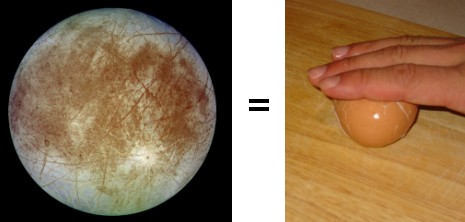The original question was:
I was reading up on Hyperion, Saturn’s moon, and one of the least dense objects in the solar system, and it hit me – what is the critical point for gravity to attract a human? In other words, if you were to make a big pile of rocks in space, at what mass would they drag a human towards them? And if you kept adding rocks to the pile, at what mass would a heap of rocks create a hot molten core?
Physicist: The answer to the first question is a bit smart-assed. The object needs to be bigger than you, or (most people would say) you’d be attracting it. No matter how small an object is, if it has mass, it has gravity. Another question might be, “How big does something have to be so that you can’t jump off of it?” It turns out that it needs to be fairly big. The Little Prince would have gone flying off of his planet if he so much as twitched.
Even Deimos (the smaller of Mars’ two moons) has an escape velocity of only about 12.5 mph, so with a good running start you could literally jump into space. I figure 12.5 mph is about the fastest that most people can muster in a pinch, so Deimos is about the smallest object that can hold people down, at about 8 miles across (8 miles on average, due to lumpiness).
It’s worth mentioning that “running” on something as small as Deimos is impossible. With a gravitational pull of about 0.04% of Earth’s, the difference between Deimos’ gravity and zero gravity is academic. You could easily pogo-stick on your pinky, and it would take so long to fall that you might lose track of which direction is down while waiting for the ground.
The main reason the size of an object is important to its core-moltenness, is because smaller objects radiate heat faster (proportionately) than larger objects, and larger objects have more nuclear fuel to work with.
As far as molten cores go, there are three main sources of heat: formation heat, tidal forces, and radioactive decay.

Tidal forces on a moon are similar to the crushing forces acting on an egg rolled on a table. In the case of Europa the end result is also similar.
Formation heat is just the left over energy you get when you let a few trillion gigatons of stuff fall together. The formation heat of everything in the solar system was exhausted billions of years ago (except for Jupiter, which continues to slowly deflate and release heat. Essentially it’s too fluffy).
Tidal forces only really apply to inner moons around gas giants. The tidal forces have to be huge in order to melt the core just by “massaging” the moon in question.
The most important thing for a liquid core is a supply of radioactive material. Given the amount of radioactive stuff left in the solar system today (it’s been draining away for the last 5 billion years) an object needs to have a mass between about 1 x 1023 kg and 3 x 1023 kg (between 0.02 and 0.05 Earths, or around 70 million “Deimoses”), give or take.
So age, size, tidal forces, and density are just some of the many variables that go into whether or not a core will be molten. In fact, given enough time Earth’s core will eventually run out of nuclear fuel and solidify. But don’t get too concerned, the Sun should swell up and swallow us long before then.








what object/material can I use for mind control???????????
I’d ask in a different way… How big does a solid object (e.g. sphere) need to be to generate enough of its own gravity to hold a grain of rice to its bottom edge? Have there ever been any experiments to prove such self-generated gravitational pull?